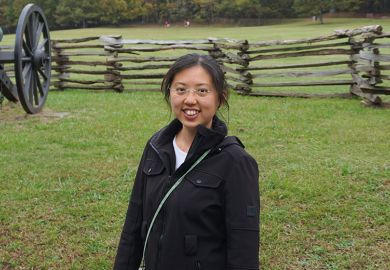Meg Crofoot is a behavioural ecologist and pioneer in the field of “movement ecology” – the study of how animals move in relation to each other. In the summer, she left the University of California, Davis to become director of the department for the ecology of animal societies at the newly established Max Planck Institute of Animal Behavior in Konstanz, Germany. She also holds an Alexander von Humboldt professorship at the University of Konstanz.
When and where were you born?
Belfast, Maine, in 1980.
How has this shaped you?
Maine is a beautiful state. It’s on the ocean and still has a lot of forest left, so I grew up outdoors. That definitely played a role in shaping my interests and shaping the kind of work I wanted to do.
What’s your first memory of being interested in how animals behave together?
My dad is a birder, so I spent a lot of time as a kid going on walks with him looking for birds. And we sailed as a family, looking out for jellyfish and porpoises and seals and birds. Like a stereotypical kid, I saw a nature documentary, when I was four or five, about orangutans in Borneo and thought, “I want to do that when I grow up.” If you ask my parents’ friends, they will tell you that when I was a little kid, I went around saying I wanted to rehabilitate orphaned orangutans.
When did you realise you could do something like this as a career?
It was a chance encounter with a professor at university who did exactly what I had dreamed of doing as a little kid – studying orangutans in the wild. That was a real eye-opening moment: [learning] that this was a real career path that people actually do, and that I could potentially take it. Kids don’t necessarily realise that these jobs exist. The stereotype that we give kids of what a scientist is is a very lab-based, white-coat sort of vision; what it means to be a scientist can be so much more diverse than that.
Why has ‘movement ecology’ become a field in its own right?
The advent of remote tracking technology and its miniaturisation – tags are getting smaller, more powerful and longer lived. We can now monitor individuals and where they’re going in incredible detail. All of a sudden, we have a new, rich source of data.
What are you now able to do in the field that was impossible before?
With baboons, we are putting GPS collars on entire groups of animals so that you can look at not just at how pairs of individuals interact, but how interactions flow across the group. Primatologists have been following and tracking animals for decades, since the 1930s. But you didn’t have that individual data. [This recent technology] has brought the ability to look at social interactions with a much more complete understanding.
What does this mean for our understanding of animal societies?
We’re just at the beginning of a really exciting phase where we have this ability to understand how the societies of other living organisms on Earth work. Think about starlings at dusk, doing an amazing, almost acrobatic, performance. We know that you can get these incredibly complex patterns of group movement from very simple rules of interaction among the individual animals.
In the baboons you’ve studied, how did seeing their movement in relation to each other change how we think about their societies?
Baboon societies are very strongly shaped by dominance relationships, among both males and females. This determines many facets of an animal’s life, like access to food, sleep sites, social partners and sexual partners. You might expect, because dominance is so important, that this is the kind of society where you’d have a leader – a despotic, dominant leader making decisions for the whole group. But from tracking the movement of a whole group came a surprising result – decisions are incredibly democratic. It’s basically a straight-up majority voting process.
How do baboons make democratic decisions?
They vote with their feet. If I’m a baboon and part of my group is going in one direction and part of it is going the other direction, I follow the majority. And eventually, the whole group reconverges on whatever choice had majority support.
How else can we track animal movements?
The lifespans of consumer drones and imaging cameras are getting better and better. You can do this kind of work without even capturing the animals, by flying drones and taking video, and using machine-learning algorithms to extract individual movement from these aerial images.
Aside from parasites and sprained ankles, what are the biggest challenges of working in a tropical forest?
There’s the forest and the animals you’re working with, but there’s also the people and the political side of the equation. We’re working on this really exciting project on a set of islands off the coast of Panama where there are capuchin monkeys that have got big brains and have all kinds of social traditions. And they’re using stone tools; it’s the only population that does that. So there’s this amazing, idyllic, totally gorgeous tropical beach setting – which also happens to be a stopover point for Colombian drugs coming to the US. This introduces interesting challenges!
Describe your typical working day.
I’m still figuring it out. I have a three-year-old, and that means that just as I figure out something that works, she changes. My work life is split between periods when I’m in the office, in Germany, and when I’m in the field. In the office, on the good days, I avoid turning on the internet until about 10am or 11am. For me, that’s writing time. I’ll spend some time working on something that actually involves getting to think about science for a few hours. Most of the rest of my day is spent either with organisational stuff or meeting with people working in my group – which is the best part of the day.
david.matthews@timeshighereducation.com
Appointments
Matthias Ruth has been appointed pro vice-chancellor for research at the University of York. Professor Ruth, who will join York in May, is currently vice-president (research and innovation) at the University of Alberta. Before that, he was director of the School of Public Policy and Urban Affairs at Northeastern University. York has also named Kiran Trehan pro vice-chancellor for partnerships and engagement. Professor Trehan, currently director of the Centre for Women’s Enterprise, Leadership, Economy & Diversity and director of external engagement at the University of Birmingham, will move to York in March. York’s vice-chancellor, Charlie Jeffrey, said the appointments were “of major significance given the importance of these portfolios as we develop a new vision for York that will define the kind of university we want to be in the future”.
The University of Texas at Austin has announced that Claudia Mora will be the next dean of its Jackson School of Geosciences. Professor Mora is currently deputy leader of the chemistry division at Los Alamos National Laboratory, and was previous head of the department of earth and planetary sciences at the University of Tennessee-Knoxville. She will move to Austin in February. Maurie McInnis, the university’s provost, said Professor Mora’s “experience in both higher education and leading research and development at one of the top laboratories in the world brings tremendous value to UT Austin”.
Heather Hancock has been elected the first female master of St John’s College, Cambridge, and will take up the role in October 2020. She currently chairs the Food Standards Agency and previously held senior roles at Deloitte and in Whitehall.
Anthony Jenkins has been named the next president of Coppin State University in Baltimore. He will move from his current role as president of West Virginia State University in May.
Register to continue
Why register?
- Registration is free and only takes a moment
- Once registered, you can read 3 articles a month
- Sign up for our newsletter
Subscribe
Or subscribe for unlimited access to:
- Unlimited access to news, views, insights & reviews
- Digital editions
- Digital access to THE’s university and college rankings analysis
Already registered or a current subscriber?








